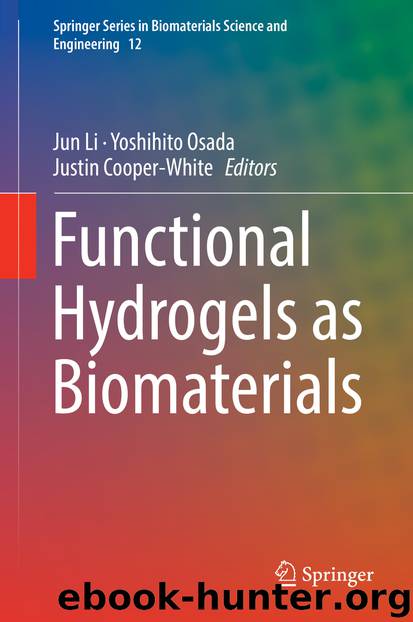Functional Hydrogels as Biomaterials by Jun Li & Yoshihito Osada & Justin Cooper-White

Author:Jun Li & Yoshihito Osada & Justin Cooper-White
Language: eng
Format: epub
ISBN: 9783662575116
Publisher: Springer Berlin Heidelberg
3.2.3 2D Versus 3D Environment
Although 2D cell culture offers a convenient platform to study stem cell behaviour and response to various physical, chemical or biological cues, it is far from being representative of the native 3D environment of the cells. Many parameters that have been shown to influence stem cell fate differ between a 2D and a 3D configuration, such as cell adhesion and morphology, the way cells sense the mechanical properties of the ECM and the transport of nutrients and gases [6].
Studies comparing the behaviour of hMSCs cultured in 2D and 3D have found that 3D conditions enhanced the differentiation potential of the cells [31]. It has been shown that the fate of hMSCs is influenced by the cell shape and cytoskeletal tension [57, 88, 134]. The way cells adhere to a 2D surface is different to attachment in a 3D environment, and by modifying the number and types of adhesions between the substrate and the cell, the morphology is likely to change, thus affecting the cell fate in terms of differentiation outcomes.
Similarly, the way cells move through a 3D environment is substantially different between a 2D and 3D environment. In 2D, cells are free to migrate and spread in any direction on the surface of the tissue culture plate. In 3D, cells need to remodel their physical environment or modify their shape in order to move through the pores of the network [136]. Again, these differences are likely to modify the cell/ECM interactions and therefore influence other fate choices, such as the differentiation outcome.
Central to many of these fate choices is the process of mechanotransduction [38], and this particular regulatory pathway is affected by the transition from a 2D to a 3D system: Huebsch et al. showed that the hMSC integrins involved in ECM interactions vary between a 2D and a 3D environment, which in turn can affect the way the cells sense and respond to the stiffness of the substrate [48]. For example, in opposition to the 2D situation, there was no correlation between the cell morphology and the cell fate, which indicates that other mechanotransduction mechanisms might be at play during the differentiation of stem cells in 3D.
Finally, when transitioning from a 2D to a 3D configuration, the diffusive parameters of the culture system are modified, which affects the transport of soluble factors, nutrients and gases [41]. Moreover, some ECM molecules can bind growth factors [87, 99] and slow down their progression. These two effects alter the diffusion of the nutrients and growth factors and generate local concentration gradients. Chemical gradients have been shown to have an effect on cell migration and differentiation, which in turn ensure the proper development of structured tissues both at the embryonic and adult stages [138]. Processes such as morphogenesis, wound healing, immune response, vascularisation, and axonal guidance are influenced by gradients [116]. Gradients in morphogens or chemokines can also be used to engineer interface tissues (e.g. from the cartilage to the bone) [109]. It is worth noting that physical gradients (e.
Download
This site does not store any files on its server. We only index and link to content provided by other sites. Please contact the content providers to delete copyright contents if any and email us, we'll remove relevant links or contents immediately.
| Automotive | Engineering |
| Transportation |
Whiskies Galore by Ian Buxton(41524)
Introduction to Aircraft Design (Cambridge Aerospace Series) by John P. Fielding(32883)
Small Unmanned Fixed-wing Aircraft Design by Andrew J. Keane Andras Sobester James P. Scanlan & András Sóbester & James P. Scanlan(32569)
Craft Beer for the Homebrewer by Michael Agnew(17927)
Turbulence by E. J. Noyes(7690)
The Complete Stick Figure Physics Tutorials by Allen Sarah(7135)
Kaplan MCAT General Chemistry Review by Kaplan(6588)
The Thirst by Nesbo Jo(6432)
Bad Blood by John Carreyrou(6270)
Modelling of Convective Heat and Mass Transfer in Rotating Flows by Igor V. Shevchuk(6219)
Learning SQL by Alan Beaulieu(6029)
Weapons of Math Destruction by Cathy O'Neil(5820)
Man-made Catastrophes and Risk Information Concealment by Dmitry Chernov & Didier Sornette(5641)
Digital Minimalism by Cal Newport;(5384)
Life 3.0: Being Human in the Age of Artificial Intelligence by Tegmark Max(5181)
iGen by Jean M. Twenge(5151)
Secrets of Antigravity Propulsion: Tesla, UFOs, and Classified Aerospace Technology by Ph.D. Paul A. Laviolette(4974)
Design of Trajectory Optimization Approach for Space Maneuver Vehicle Skip Entry Problems by Runqi Chai & Al Savvaris & Antonios Tsourdos & Senchun Chai(4837)
Electronic Devices & Circuits by Jacob Millman & Christos C. Halkias(4739)
